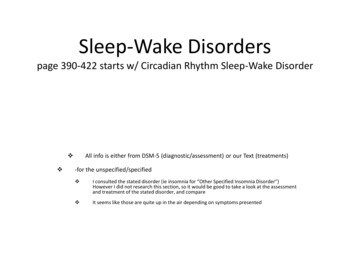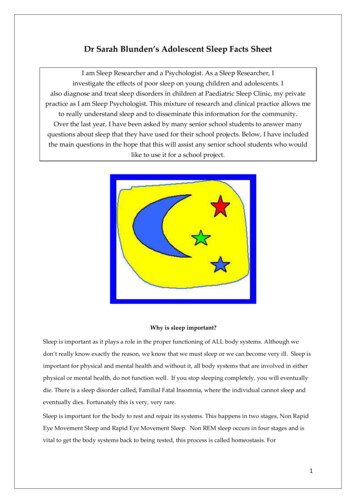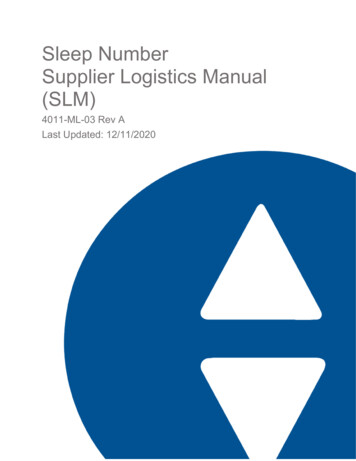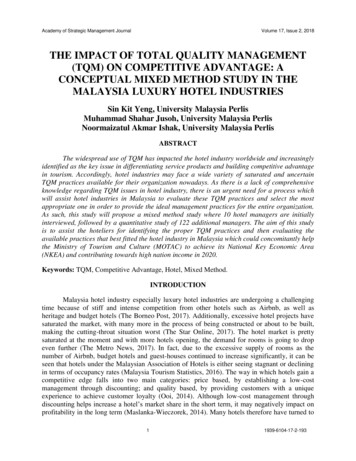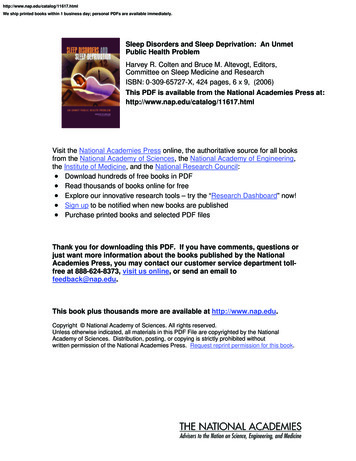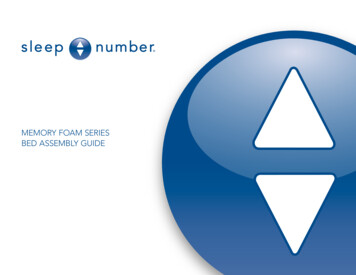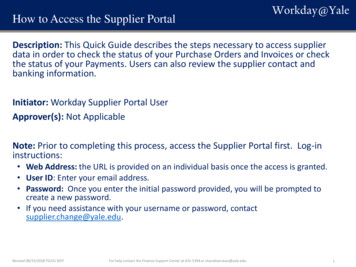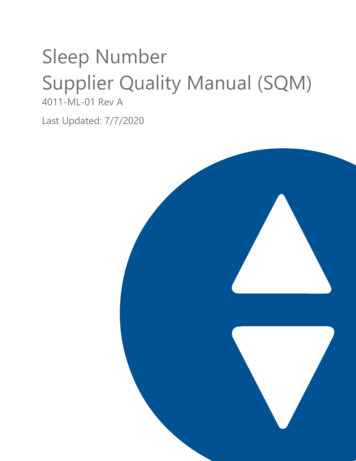
Transcription
Sleep NumberSupplier Quality Manual (SQM)4011-ML-01 Rev ALast Updated: 7/7/2020
Table of Contents1.0 Introduction . 22.0 Scope . 33.0 General Expectations . 44.0 Quality Management Requirements . 54.1 Sub-Tier Management . 54.2 Resource Management . 54.3 Test and Measurement Equipment . 64.4 Process and Record Control . 65.0 Supplier Qualification. 75.1 Supplier Business Profile / Financial Risk Assessment . 75.2 Supplier Self-Assessment . 75.3 Sleep Number–Led Assessments . 85.4 Supplier Development Plan . 85.5 Qualified Supply Base (QSB). 86.0 Product Qualification . 106.1 Advanced Product Quality Planning (APQP) . 106.1.1 Product Planning and Quality Program. 106.1.2 Product Design and Development . 116.1.3 Process Design and Development. 116.1.4 Validation of Product and Process . 127.0Launch . 157.1 Safe Launch . 158.0 Post-Launch Requirements . 168.1 Deviation Request and Request for Change . 168.2 Nonconformance . 188.2.1 Discrepant Material Report (DMR) . 188.2.2 Supplier Corrective Action Request (SCAR) . 188.2.3 Controlled Shipping Level (CSL) . 198.3 Supplier Scorecard . 208.3.1 Supplier Development Program. 209.0 Revision History . 21Supplier Quality Manual (SQM)4011-ML-01 Rev A7/8/2020UNCONTROLLED IF PRINTEDPage 1
1.0 IntroductionOur core values are at the heart of our mission. Our culture defines our brand because everything we docenters on our customer and each other.Five values support our culture:Passion, Integrity, Innovation, Courage and Teamwork.This manual defines the minimum quality requirements, processes, and systems for doing business withSleep Number—and aligns Suppliers to Sleep Number’s customer expectations. The manual outlinesprocesses used to ensure that Sleep Number’s supply base is providing top-level performance and iscontinually improving to prevent quality and delivery disruptions. It is the responsibility of the Supplier’sleadership to ensure compliance to this manual.Sleep Number recognizes that Suppliers are instrumental in meeting the commitment to obtaining ontime, defect-free products to the end consumer. The goal is only achieved by attaining a collaborativerelationship based on mutual trust, respect, and open communication.Supplier Quality Manual (SQM)4011-ML-01 Rev A7/8/2020UNCONTROLLED IF PRINTEDPage 2
2.0 ScopeThe content in this manual applies to All direct Suppliers providing existing and new materials, parts, assemblies, and services whichdirectly impact the quality of Sleep Number productsThe product life cycle, which encompasses three main areas: Supplier qualification, newproduction development/introduction, and productionQuality requirements, which are in addition to all engineering requirementsSleep Number’s relationship with Suppliers is defined by the provisions, terms, and conditions of thepurchase order, or—where applicable—the contract with the Supplier. Compliance with the guidelinesof this manual or acceptance/approval of the Supplier’s parts or materials does not relieve the Supplierof any obligations or liabilities stated in the purchase order or contract.In the event of conflict, the following order of precedence shall apply: Design RecordPurchase Order/ContractProcurement SpecificationsSupplier Quality ManualSupplier Quality Manual (SQM)4011-ML-01 Rev A7/8/2020UNCONTROLLED IF PRINTEDPage 3
3.0 General ExpectationsOur MissionOur VisionTo improve lives byindividualizing sleepexperiencesTo become the world’s most belovedbrand by delivering unparalleledsleep experiencesProduct LifecycleThe Product Lifecycle is the stage-gate process Sleep Number follows for a product launch. At any placewithin this document, refer to the Sleep Number logos below to indicate what part of our productlifecycle that section of the manual applies to. If the logo is blue, that section applies to that stage ofour product lifecycle. General Expectations apply to all stages as indicated below.Critical Definitions: Shall – The word “Shall” indicates mandatory requirements. Should – The word “Should” indicates a recommendation.Sleep Number suppliers shall strive to deliver zero defects to our plants, hubs, and customers. Obtainingzero defects requires a proactive approach to managing quality that focuses on prevention, continuousimprovement, and immediate incorporation of lessons learned. These concepts should be embeddedwithin the supplier’s quality management system to drive an unparalleled Sleep Number customerexperience: Review, understand and ensure compliance to this manual as a part of doing business with SleepNumber.Adhere to all quality requirements.Ensure that Sleep Number requirements are adequately communicated to their Sub-TiersuppliersSleep Number will provide updates and revisions to this manual as necessary. Suppliers are expected toincorporate these updates and revisions into their quality system in a timely manner. If changesgenerate a question or potential problem for a supplier, it is the supplier’s responsibility to bring theissue to the attention of Sleep Number.Supplier Quality Manual (SQM)4011-ML-01 Rev A7/8/2020UNCONTROLLED IF PRINTEDPage 4
4.0 Quality Management RequirementsSleep Number recommends that the Supplier’s QMS is either registered or compliant to the current ISO9001 or IATF 16949 requirement. If the Supplier is not registered to one of the standards, the Supplier isencouraged to become registered.The Supplier’s QMS shall: Support Sleep Number’s quality requirements as defined in this manualEnsure, no less than annually, that a comprehensive quality system audit is conducted andavailable upon request. The audit may be conducted internally, by a third party, or by SleepNumber. Sleep Number reserves the option of requesting that the Supplier take specificaction(s) upon review of the audit resultsSleep Number shall: Develop a Supplier audit frequency based on product risk and maintain that schedule in theSupplier Relationship Management (SRM) system. The supplier audit frequency shall becommunicated to the supplier.4.1 Sub-Tier ManagementSuppliers are fully responsible to manage Sub-Tier Supplier performance in order to meet orexceed Sleep Number business expectations. Suppliers shall establish and maintain proceduresto ensure Sub-Tier Suppliers comply with the functional requirements defined in this manual.Procedures shall include but are not limited to Distribution of drawings/specificationsDistribution of quality requirements/packaging and label standardsProper level of part traceability (lot/date codes)Tier 1 Suppliers shall maintain revision control methods that are properly embedded in theirsystems and that can be retrieved within a 24-hour notice. Tier 1 Suppliers shall ensure Sub-Tier(or Tier 2) Suppliers are managing proper material lead times and maintenance of fixtures andtooling. Tier 1 Suppliers shall provide the remaining useful life of tools, including those withinthe Sub-Tier Supplier base, on an annual basis to Sleep Number.4.2 Resource ManagementEmployees shall be qualified for their respective jobs through education, training, and workexperience.Employees shall be knowledgeable about appropriate quality tools and processes that affect thequality of products and services provided to Sleep Number.Employees shall be provided with equipment, facilities, and a work environment conducive toproducing high-quality products and services that consistently meet functional requirementsand product specifications.Supplier Quality Manual (SQM)4011-ML-01 Rev A7/8/2020UNCONTROLLED IF PRINTEDPage 5
4.3 Test and Measurement EquipmentOverview: The Supplier shall identify key process equipment, provide resources formachine/equipment maintenance activities, and develop an effective planned total preventivemaintenance system.Description: The Supplier shall determine the monitoring, measurements, and maintenance tobe performed and the devices needed to provide evidence of a product’s conformity todetermined requirements. Sleep Number shall review and approve the Supplier’s proposal.At a minimum, and where necessary to ensure valid results, measuring equipment shall be calibrated or verified at specified intervals, or prior to use, against measurementstandardstraceable to international or domestic measurement standards; where no suchstandards exist, the basis used for calibration or verification shall be recordedmaintained in a system used to track the calibration status4.4 Process and Record ControlOverview: The Supplier shall prepare documented process monitoring and operator instructionsfor all employees responsible for process operation of Sleep Number components and products.These instructions shall be easily accessible for use by the production manufacturing personnel.Description: Suppliers shall establish and document process standards and controls for allaspects of the manufacturing operations. This is necessary in order to prevent defectiveproducts from being delivered to Sleep Number and to ensure production operationconsistency, enable continuous improvement, and control cost. Process controls shall bereferenced in an approved control plan when required/appropriate.Process monitoring and operator instructions may take the form of process sheets, inspectionand laboratory test instructions, shop travelers, test procedures, standard operation sheets,calibration and Gage R&R recurrence schedules, or other documents normally used by theSupplier. Supplier quality records shall be established to provide evidence of conformity to SleepNumber and industry requirements.Sleep Number expects Suppliers to maintain all quality records and applicable testspecimens for the life of the product plus one year.All Supplier communication to Sleep Number shall be in English, including but notlimited to forms, part approval submissions, product assurance documentation, andgeneral communication.Supplier Quality Manual (SQM)4011-ML-01 Rev A7/8/2020UNCONTROLLED IF PRINTEDPage 6
5.0 Supplier QualificationSleep Number follows a structured stage-gate governed process to assure the best Supplier(s) for thebusiness need are selected, which allows for a successful long-term business partnership. Effectivequalification, training, and onboarding have mutual benefits for both the Supplier and Sleep Number,including improved alignment of goals and reduced risk at launch.The qualification and onboarding process deliverables vary dependent on the criticality of component(s)being supplied as well as on the business needs.Common deliverables include the following: Supplier Business Profile and Financial Risk AssessmentSupplier-led Self-Assessment(s)Sleep Number– led QMS/Manufacturing Assessment(s)Gap Closure and Action PlanComprehensive Training PlanUpon successful completion of the required deliverables, the potential Supplier is qualified and added tothe Qualified Supply Base (QSB) for consideration of future business, but only for goods and services inthe categories for which they were approved.If an existing Supplier to Sleep Number is expanding into any additional categories or adding a newlocation, they must follow this process and be approved before they can ship product in the newcategory, or from the new location. To avoid disruption to future shipments, it is important for Suppliersto notify their Sleep Number Sourcing Manager or Supplier Quality Representative promptly when thesebusiness changes are anticipated, to allow enough time to complete the approval process.5.1 Supplier Business Profile / Financial Risk AssessmentOverview: The Supplier Business Profile / Financial Risk Assessment is a collection of criticalbusiness information related to the manufacturing and/or distribution location(s). This profile isinitially used as part of the Supplier qualification process.Description: Upon qualification, this information is used for future business consideration,corporate communication, and Supplier relationship management. The Supplier Business Profileis required upon request and shall be returned to sourcing for review.Note: If any business changes are made from the initial profile submitted, it is up the Supplier tonotify Sleep Number of those changes.5.2 Supplier Self-AssessmentOverview: The Supplier Self-Assessment is used by the Supplier to assess the performance oftheir QMS, manufacturing capability, and capacity.Supplier Quality Manual (SQM)4011-ML-01 Rev A7/8/2020UNCONTROLLED IF PRINTEDPage 7
Description: Once a prospective Supplier is identified, a Supplier development representativewill send the Sleep Number Self-Assessment form to them. The Supplier should perform thisself-assessment accurately and return it to Sleep Number in a timely manner. Assessmentquestions will auto-generate an overall score as well as specific category/element scores. SleepNumber uses this assessment as a guide for the Sleep Number–led assessment(s).5.3 Sleep Number–Led AssessmentsOverview: There are two types of Sleep Number– led assessment tools: QMS Assessment: used to assess the Supplier’s level of implementation toward aneffective QMSManufacturing Assessment: used to assess the Supplier’s ability to consistentlymanufacture a product that meets Sleep Number expectationsDescription: The objective of the Sleep Number–led assessment is to ensure the highest qualitystandards resulting in an optimal customer experience. The assessment, in general, evaluatesthe Supplier’s QMS, manufacturing processes, delivery performance, and technologicalcapabilities. These assessments may be performed at any time during the product life cycle.Sleep Number will perform the assessment on-site at the Supplier’s location. If multiplelocations are used, each site will have a separate assessment. The results of the assessment willbe used to determine if any further Supplier development plans are appropriate.5.4 Supplier Development PlanOverview: The Supplier Development Plan is a tool used to address deficiencies found in theSleep Number–led assessments. In the last stage of the Supplier qualification process, this stageis intended to support the Supplier by providing the tools and training necessary to drivesystemic performance improvements.Description: Once Sleep Number identifies area(s) of opportunity, the Supplier shall submit acorrective action plan to address and correct the deficiencies. Sleep Number will then reassessand validate that the improvements meet or exceed Sleep Number’s quality level5.5 Qualified Supply Base (QSB)Overview: QSB is a concept used to evaluate Supplier performance and to identify areas ofimprovement. The QSB score is used as a factor for future sourcing decisions and is a subset tothe Supplier Scorecard.Description: QSB is a combination of quality and delivery metrics based on the last 6-months ofperformance data and is grouped into four categories: Supplier DevelopmentSupplier QualityProduct AssuranceSupplier PerformanceSupplier Quality Manual (SQM)4011-ML-01 Rev A7/8/2020UNCONTROLLED IF PRINTEDPage 8
For each category(s) of supplied parts, scoring indicates a qualified or conditional status. AQualified or Non-Qualified status will be scored and used as an input to Sleep Number’s sourcingdecisions, including whether to maintain current business. Non-Qualified status denotes thatmultiple indicators of performance are below the minimum allowable threshold. As part of theNon-Qualified status, the Supplier is placed on new business hold. The minimum thresholdbetween Qualified or Non-Qualified status may be adjusted to adapt to changing Sleep Numberquality requirements.Supplier Quality Manual (SQM)4011-ML-01 Rev A7/8/2020UNCONTROLLED IF PRINTEDPage 9
6.0 Product QualificationSleep Number uses a New Product Introduction (NPI) stage-gate life cycle process when developing andqualifying new products.Sleep Number’s Product Qualification Process is modeled from the Advanced Product Quality Planning(APQP) structure. The goal of this process is to create a product quality plan for developing andmanufacturing products that meet or exceed our customer requirements. Methodical and sequencedproduction qualification helps sustain successful and long-term business partnerships.The APQP uses a four-phase process: Product Planning and Quality ProgramProduct Design and DevelopmentProcess Design and DevelopmentValidation of Product and Process6.1 Advanced Product Quality Planning (APQP)Overview: The APQP framework is a structured method of defining and establishing the stepsnecessary to assure that a product satisfies the customer.Description: The primary goal of APQP is to Facilitate collaboration and communicationEnsure the voice of the customer is clearly understood and translated intorequirements, technical specifications, and characteristicsReduce risk associated with the launch of a new product by early identification ofrequired changes and avoidance of late design changesAs a project moves through the NPI stage-gate process at Sleep Number, a set of deliverablesare determined and communicated to the Supplier for engagement. The level of thequalification process varies depending on the criticality of the component(s) and Sleep Numberbusiness needs. Reconciling issues will be critical before moving to the next stage of the NPIprocess (product launch).6.1.1 Product Planning and Quality ProgramThe product planning phase includes gathering necessary data to define customer needsand translate that to product characteristics. The quality program defines the productreliability, quality goals, and manufacturing quality assurance plan. It is very important toalso consider the historical warranty and quality information.The output will be setting design goals, reliability and quality goals, and cost ofnonconformance targets; creating preliminary BOMs and process flows; and, mostimportantly, making sure the customer needs and expectations are understood.Supplier Quality Manual (SQM)4011-ML-01 Rev A7/8/2020UNCONTROLLED IF PRINTEDPage 10
6.1.2 Product Design and DevelopmentThe product design and development phase captures outputs from the product planningphase such as design features and characteristics and are developed into a near-final form.The Supplier should consider all design factors in this quality planning process, even if thedesign is owned by the customer. The steps listed below are employed to verify that theproduct or service meets the objectives of Sleep Number.6.1.2.1 Technical Drawing ReviewTechnical drawing and specifications reviews are an essential element for a clear andcomprehensive understanding of Sleep Number requirements. The result of this reviewis a thorough understanding regarding drawings, compliance requirements, functionalityof the parts, and any subsequent specifications needed.Technical drawing reviews are essential for communicating ideas, changes, or potentialcost savings from the Supplier to Sleep Number. The design review is also needed tomake sure the drawings, symbols, perspectives, units of measurement, notationsystems, visual styles, and page layout, etc., are understood by the Supplier.Suppliers are ultimately responsible for the review of Sleep Number drawings, relatedspecifications, and standards to ensure the Supplier’s ability to meet Sleep Numberrequirements.Suppliers shall adhere to the latest design revision and maintain proper documentcontrol. Only current revision levels as noted on the purchase order may be used forproduction purposes unless a Sleep Number deviation is granted. Obsolete revisionlevels shall be controlled in a manner that ensures they are not used for production.6.1.2.2 Design Failure Mode & Effects Analysis (DFMEA)The DFMEA is a disciplined analytical technique that assesses the probability of failureas well as the effect of such failure. A DFMEA is a living document continually updatedas required by customer needs and expectations. Preparing the DFMEA provides theteam an opportunity to review the previously selected product and processcharacteristics and make necessary additions, changes, and deletions.6.1.3 Process Design and DevelopmentThe focus on process planning throughout the development of the process design willproduce improved product while ensuring specifications, product quality, and productioncosts are met.This phase consists of developing the major features of a manufacturing system and therelated control plans to achieve quality products. The tasks to be accomplished at this stepof the product quality planning process depend upon the successful completion of the priorphases. This step is designed to ensure the comprehensive development of an effectivemanufacturing system.Supplier Quality Manual (SQM)4011-ML-01 Rev A7/8/2020UNCONTROLLED IF PRINTEDPage 11
6.1.3.1 Process Failure Mode & Effects Analysis (PFMEA)A PFMEA is a disciplined review and analysis of a new/revised process and is conductedto anticipate, resolve, or monitor potential process problems for a new/revised productprogram. The PFMEA should also be conducted during product quality planning andbefore beginning production. A PFMEA is a living document and needs to be reviewedand updated as new failure modes are discovered. Any high failure modes or risks fromthe DFMEA (see 6.1.2.2) are a critical input to the PFMEA. Compilation of the PFMEAshould include and identify all the process steps in the DFMEA that may compromiseparts.6.1.3.2 Process Control PlanThe Process Control Plan is a document that describes the actions (measurements,inspections, quality checks, or monitoring of process parameters) required at eachphase of a process to assure the process outputs will conform to pre-determinedrequirements. The control plan provides an operator or inspector with the informationrequired to properly control the process and produce quality parts or assemblies. Itshould also include instructions regarding actions taken if nonconformance is detected.The control plan does not replace detailed operator/inspector instructions. In somecases, the control plan is used in conjunction with an inspection sheet or checklist. Thecontrol plan helps assure quality is maintained within a process in the event ofemployee turnover by establishing a standard for quality inspection and processmonitoring. Control plans are living documents that should be periodically updated asthe measurement methods and controls are improved throughout the life cycle of theproduct.6.1.4 Validation of Product and ProcessThe validation of product and process phase consists of validating the manufacturingprocess through a production trial run evaluation. During a production trial run, the Suppliershall validate that the control plan and process flow chart are being followed and theproducts meet customer requirements. Additional concerns shall be identified forinvestigation and resolution prior to regular production runs. The validation of themanufacturing process phase includes confirming capability and reliability of themanufacturing process and product quality acceptance. The output of this phase is anapproved PPAP (noted below).6.1.4.1 Launch Readiness ReviewA complete evaluation of launch readiness reviews will be evaluated by Sleep Numberto make sure the Supplier has all the necessary documents, processes, and proceduresin place prior to PPAP submission (see 6.1.4.2).Supplier Quality Manual (SQM)4011-ML-01 Rev A7/8/2020UNCONTROLLED IF PRINTEDPage 12
The launch readiness review is an assessment of a Supplier’s readiness to manufactureand produce the intended design. This process also verifies all key process elements areidentified on the control plan and are in place prior to full production. The output of thisreview performed by Sleep Number will determine if the Supplier is ready to begin thenext step in the process.6.1.4.2 Production Part Approval Process (PPAP)PPAP is a rigorous, structured process for part qualification and is required for approvalof any new or changed parts that are used for production by the Supplier. The SleepNumber PPAP package is comprised of 14 elements and is modeled from the ProductionPart Approval Process (PPAP) 4th Edition by the Automotive Industry Action Group(AIAG).A PPAP provides evidence that all customer engineering design records and specificationrequirements are properly understood and implemented by the Supplier. PPAP alsodemonstrates that the manufacturing process has the potential to produce a productthat consistently meets all requirements during an actual production run at the quotedproduction rate. This process shall be used in conjunction with and during the NPI stagegate process. Suppliers shall ensure the PPAP is performed at their Sub-Tier Suppliers asrequired.Sleep Number may request PPAP for parts that meet the following conditions: New or Changed PartsTooling ChangesSupplier ChangesProcess and Product ChangesAppearance ChangesRefer to the table below for Sleep Number PPAP requirements.Supplier Quality Manual (SQM)4011-ML-01 Rev A7/8/2020UNCONTROLLED IF PRINTEDPage 13
Sleep Number PPAP requirements:Sleep Number NPIStageRequirementPlanning (Stage 1)Development (Stage 2)Process FlowchartBOM AnalysisDFMEAPFMEAValidation (Stage 3)Capability StudyMaterial, PerformanceTest ResultsFull-LayoutControl PlanGage R&R (if applicable)Appearance ApprovalReport (AAR) (ifapplicable)Packaging ApprovalCertificates (COA, COC)Sample Product (Master)Warrant* Required if Supplier has design control.Sleep Number PPAP XXXXXXXAdditional PPAP notes: Requirements shown for each PPAP level are minimum requirementsPPAP’s that require level 5 will be performed on site at the supplier’smanufacturing location.Sleep Number does not accept separate charges for the cost of PPAP development.Suppliers shall factor the cost of PPAP development into the overall cost of doingbusiness.The Run @ Rate shall be performed before the Supplier has attained a PPAP approval,unless otherwise approved by Sleep Number’s supplier quality representative.All PPAP submissions shall have conditional or full approval by Sleep Number prior toproduct shipment.6.1.4.3 Run @ RateThe purpose of the Run @ Rate is to verify that a Supplier’s manufacturing process canproduce quality products according to the Sleep Number forecast or plan. During theRun @ Rate, the Supplier’s manufacturing process will be assessed to verify its ability tomeet the quality and capacity requirements as contracted and detailed in the ProcessControl Plan.Supplier Quality Manual (SQM)4011-ML-01 Rev A7/8/2020UNCONTROLLED IF PRINTEDPage 14
The duration of the Run @ Rate shall be
Sleep Number recommends that the Supplier's QMS is either registered or compliant to the current ISO 9001 or IATF 16949 requirement. If the Supplier is not registered to one of the standards, the Supplier is encouraged to become registered. The Supplier's QMS shall: Support Sleep Number's quality requirements as defined in this manual
